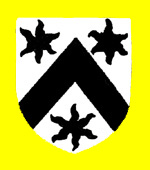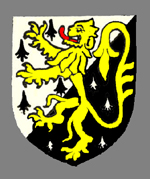Dylywyk alias Wick End Manor Stagsden
Volume III of The Victoria County History, published in 1912, details all the manors in the parish of Stagsden. The Domesday Book of 1086 recorded for landowners in Stagsden. The largest holding was that of Hugh de Beauchamp, later created Baron of Bedford and the whole parish, except Gemys, Jempsis or Stanford Manor was later attached to the Barony of Bedford.

The arms of the Barony of Bedford
Dylywyk was the most important of the Stagsden manors and was held from the Barony as overlord until 1265 when the last baron, John de Beauchamp died at Evesham fighting for Simon de Montfort against King Henry III (1216-1271). His property was then divided amongst his three sisters with Dylywyk Manor going to Beatrice, wife of Thomas FitzOtho. Her second husband was William de Monchensey, who held her estates until his death in 1286.

The Latimer coat of arms
Maud FitzOtho, Beatrice's daughter, married John Botetourt and, in 1328, settled the manor on her daughter Elizabeth, wife of William, Lord Latimer. In 1384 Latimer's granddaughter, who married John Nevill of Raby, inherited Dylywyk.

The Mordaunt family arms
The manor continued in the Nevill family until 1589 when the manor was alienated by Lucy, co-heir of Lord Latimer, and her husband William Cornwallis, to Lewis, Lord Mordaunt. The manor remained in the Mordaunt family until 1710 when it was purchased by Sir Thomas Trevor of Bromham.

Trevor, Lord Hampden - arms
Sir Thomas was appointed Chief Justice of Common Pleas on the accession of Queen Anne (1702-1714) and, in 1712, was created Baron Trevor of Bromham. he died in 1730 and was succeeded by his eldest son who died without issue in 1754 and was succeeded by his brother John. He also died without male issue in 1764 and his half brother Robert succeeded. He assumed the name and arms of the Hampden family and was created Viscount Hampden in 1776. At this time Dylywyk Manor disappears from the historical record as it was united with Bosoms and Burdelys Manors under the common name of Stagsden Manor.
Viscount Hampden's son died childless in 1824 and his heir, his brother John, died in the same year. Stagsden Manor then passed to George Rice Rice, son of George, 3rd Baron Dynevor. In 1873 the manor was purchased by the Crown from Lord Dynevor's estate.
Dylywyk Manor had a park attached to it, mentioned in Domesday Book. It was specifically designed for hunting and in 1278 comprised 180 acres. By 1396, however, it was worth little, except that Gilbert Deye, the parker, drew a salary of £4 per annum. It is last mentioned during the 18th century. Information from Ann Hagen reveals that the park lay to the south-west of the village, as revealed by field names. The site of the manor lay west of Astey Wood and Gallows Field where traces of a filled-in moat survive.